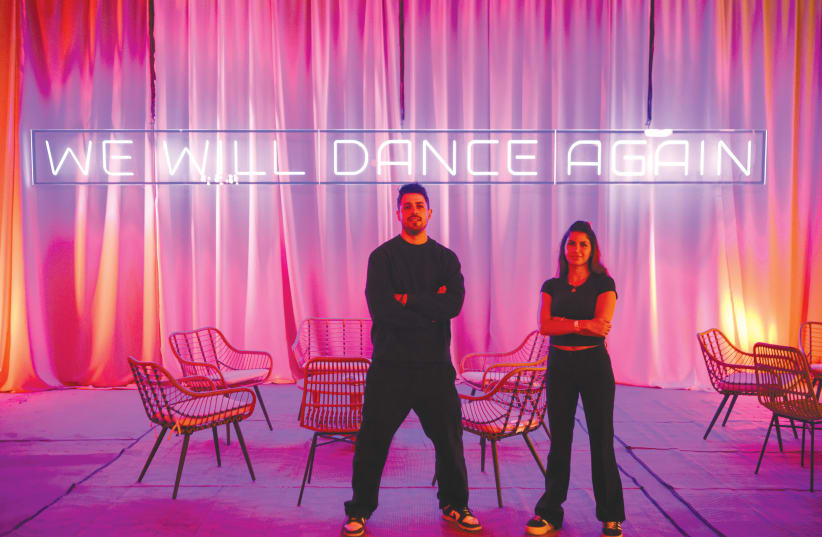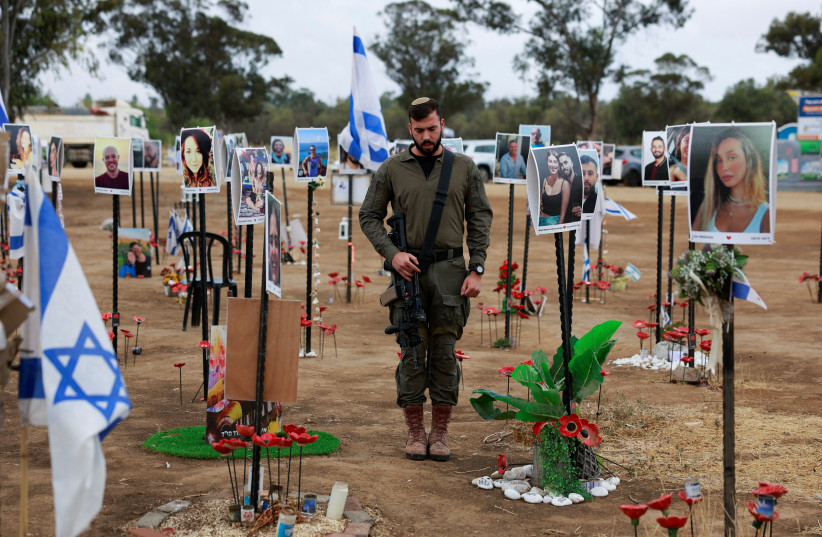NEW YORK – If you live in Israel, you probably know that the barefoot young Israeli woman in the gray bloody sweatpants who was shoved by her hair into a Hamas jeep is 19-year-old Na’ama Levy, still a hostage in Gaza.
If you’re Israeli, you probably know of people who died at the Supernova music festival at dawn on October 7, when 370 were killed and 44 were kidnapped.
You’d likely know the fate of the young partygoers hiding among the trees and taping videos to their parents. You have probably heard the audio of the terrorist bragging to his father, “Dad, look how many Jews I killed! I killed 10!” or watched as Hamas terrorists gather for prayer before they head to breach the barrier into Israel, calling out with glee “God is Great!”
That’s because for Israelis, videos of October 7 – especially from the music festival – have been replayed so many times that many can’t bear to watch them.
But for Americans, it’s a different story. That’s why the Nova Music Festival Exhibition: The Day The Music Stood Still – now showing in New York City until May 25, soon to move to other American and European cities – is a wholly different one than the one that ran in Tel Aviv in December.
Like the Israeli exhibit, the American one still uses original artifacts from the festival to recreate the original rave, down to the finest detail, but now in a 50,000-square foot installation.
In a dark, eerie space lit only by camping lights, dusty tents with sleeping bags are set up on striped Bedouin-style rugs, under green shrubbery, with beach chairs overturned haphazardly, the smell of incense lending an overwhelming sensual verisimilitude to make you feel like you are there: at the Nova rave in the desert, partying all night, awaiting a beatific dawn that never came.
Exhibit provides testimony to the harrowing events of Oct. 7
Unlike the Israeli exhibit, here video testimony is featured at every tent station: some on screens strewn sideways in the tents, others from phones nestled in the bushes, showing footage of Israelis in hiding, terrorists chasing.
“We didn’t want to show videos of the terrorists in Israel. The exhibit was in Israel two months after the attacks, and we knew that everyone there knows the story. It was on the news every day. It was too hard to watch, two months later. It was traumatic,” said Supernova music festival co-founder Omri Sasi, who also founded the Israel exhibit with Yoni Feingold, Ofir Amir and Yagil Rimoni.
“The difference from the exhibit in Israel and New York is we understood the audience is a different audience that doesn’t know the whole story,” said Sasi, whose own story of survival is featured at the penultimate section of the exhibit, where survivors tell their stories near burnt, bullet-ridden cars, tables of shoes, and other items left at the festival, echoing the Holocaust.
“I’ve been pleasantly surprised by the diversity of the attendance at the exhibit,” said Josh Kadden, one of the US partners of The Nova Music Festival Exhibition, along with Scooter Braun and Joe Teplow. Kadden said that music is a universal language that most people connect to.
“Walking through the Nova Exhibit, no matter who you are, you feel a sense of ‘it could have been me.’”
FOR SOME visitors already achingly familiar with the atrocities of October 7, the exhibit still affected them.
“I’ve seen so many videos and read so many testimonies that when I walked through the exhibit, it was almost like there wasn’t any video I hadn’t seen before,” said Bena Medjuck-Bruckner, an Upper West Side mother who is involved with Jewish education and community organizing.
“They did such great storytelling that put it all together, starting with learning about the music community itself,” she said, referring to the opening video.
In the five-minute opening film, Nova attendees describe the beauty, love, and peace at the all-night festival. “The sunrise is filled with magic. There’s only the music, just the sun, something energetic that you can’t explain it,” one dancer says. Another adds, “Little did we know it would be our last dance.”
Medjuck-Bruckner said that learning about the peacefulness of the rave community, “I realized how much we all know but still have more to learn – and it was very, very real,” she said. “It made me feel like I was honoring the people who were at that festival, and I feel like I have a responsibility to them to hear their stories, to hear what survivors are saying, and then also to see how they have taken the community past this massacre and tried to lift them up through the Tribe of Nova Foundation.”
Other visitors, less familiar with the imagery of the attacks, were devastated after seeing the exhibit, which culminates with a candle-lit Memorial Wall showing more than 350 photos of people killed at the festival, a “Bring Them Home” hostage wall, ultimately emptying out into a “healing tent” installation, a lighthouse asserting, “We will dance again.”
“I mean, I knew but I didn’t,” said Dina Mouldovan, a clinical social worker from Manhattan’s Washington Heights, who said she’s not really on social media so she didn’t see a lot of the images that many others did of October 7.
“It was horrific to see what happened to these people that were trying to celebrate living and love and they were just completely destroyed by these terrorists that came in and seem to be celebrating. There’s a lot of video footage of a mass kind of rejoicing in these horrific actions,” she said. “It was devastating to see.”
Tal Bodner, whose parents are Israelis living on Long Island, said it’s important for people her age (25) to see these videos unfiltered.
“You can see some of these videos on TikTok, but then they’re filtered with a lot of antisemitic rhetoric or just anti-Israel rhetoric, and so they’re not getting the picture,” she said, noting that most kids her age get their news from TikTok. “The picture here is truly painted, as this is what happened on October 7.... People forget that Hamas started this, and that Israel actually was in no way trying to have this war.”
Bodner said she wants to bring as many people as possible to the exhibit. “We’re talking about a festival where people were coming to dance and have fun. It was truly the most evil thing they [Hamas] could have done.”

